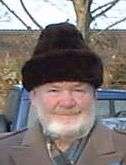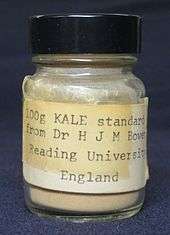Humphry Bowen
Humphry John Moule Bowen (22 June 1929 – 9 August 2001) was a British botanist and chemist.[3][4][5][6][7]
Humphry John Moule Bowen | |
|---|---|
 Humphry Bowen in 1999 | |
| Born | 22 June 1929 Oxford, England |
| Died | 9 August 2001 (aged 72) Dorset, England |
| Nationality | British |
| Alma mater | Magdalen College, Oxford |
| Known for | Study of trace elements, Bowen's Kale, two English county floras (Berkshire[1] and Dorset[2]) |
| Scientific career | |
| Fields | Analytical chemistry, botany, lichenology |
| Institutions | Atomic Energy Research Establishment University of Reading |
Bowen was born in Oxford, son of the chemist Edmund Bowen.[8] He attended the Dragon School, gaining a scholarship to Rugby School and then a demyship to Magdalen College, Oxford. He won the Gibbs Prize[9] in 1949 and completed a DPhil in chemistry at Oxford University in 1953 before starting his professional career as a chemist. Bowen was also a proficient amateur actor in his early years, appearing with a young Ronnie Barker at Oxford.
His first post was with the Atomic Energy Research Establishment (AERE), working at the Wantage Research Laboratory, then in Berkshire. His early work started an interest in radioisotopes and trace elements that he maintained throughout his working life. While at AERE, he spent several months in 1956 attending the British nuclear tests at Maralinga in Australia to study the environmental effects of radiation.

Bowen realised that the calibration of different instruments intended to measure trace elements was an important issue that needed addressing. His solution was to produce a good supply of a material which later become known as Bowen's Kale. With Peter Cawse, he grew a large amount of the plant kale, then dried and crushed it into a homogeneous and stable substance that he then freely distributed to researchers around the world for years to come. This was probably the first successful example of such a standard.
In 1964, he was appointed as a lecturer in the chemistry department at the University of Reading. Later he was promoted to Reader in analytical chemistry in 1974. At Reading, Bowen undertook consultancy for Dunlop, investigating potential uses for their products. When the Torrey Canyon oil disaster occurred in 1967, he realised that it might be possible to use foam booms to block the oil from spreading in the English Channel. His original experiments were conducted in a small bucket in his laboratory. Although not entirely successful in reality at the time due to the rough seas, this lateral thinking combined his interest in chemistry with his love of nature and has since been effectively deployed to protect ports and harbours against encroaching oil slicks. Bowen wrote a number of professional books in the field of chemistry, including two editions of Trace elements in Biochemistry (1966 and 1976).[11]
From 1951 onwards, Bowen was a long-serving member of the Botanical Society of the British Isles (BSBI). He was meetings secretary for a period and the official recorder of plants for the counties of Berkshire and Dorset, producing Floras for both counties.[1][2] He retired to Winterborne Kingston in Dorset at the end of his life. He was also one of the leading contributors of botanical data for the Flora of Oxfordshire.[12] He acted as an expert botanical guide on tours around Europe, especially Greece.
Humphry Bowen donated a large collection of lichens from Berkshire and Oxfordshire to the Museum of Reading in the 1970s.[13] He established the Bowen Cup at the University of Reading in 1988, an annual prize for the student in the Department of Chemistry at the University who achieves the top marks in Part II Analytical Chemistry.[14]
See also
- Bowen's son, Jonathan Bowen, a computer scientist.[8]
- George Claridge Druce, the Victorian botanist who also wrote floras for more than one county.
- Tottles.
Bibliography
- H. J. M. Bowen, Trace Elements in Biochemistry. Academic Press, 1966.
- H. J. M. Bowen, Properties of Solids and their Structures. McGraw-Hill, 1967.
- H. J. M. Bowen, Environmental Chemistry of the Elements. Academic Press, 1979. ISBN 0-12-120450-2.
References
- Bowen, H. J. M. (1968). The Flora of Berkshire. Oxford: Holywell Press.
- Bowen, H. J. M. (2000). The Flora of Dorset. Pisces Publications. ISBN 1-874357-16-1. Archived from the original on 2 September 2006.CS1 maint: BOT: original-url status unknown (link)
- "Obituary: Humphry Bowen". The Times. 28 August 2001. Archived from the original on 2 December 2007. Retrieved 4 June 2013.
- Moffatt, J. Michael (17 October 2001). "Humphry Bowen: Practical botanist and chemist exploring the natural world". The Guardian. Retrieved 4 June 2013.
- "Obituaries: Humphry Bowen". The Daily Telegraph. 5 September 2001. Retrieved 4 June 2013.
- "Obituaries: Humphry Bowen". The Independent. 25 September 2001. Retrieved 6 October 2011.
- Jury, S. L. (2002). "Humphry John Moule Bowen (1929–2001)". Watsonia. 24: 268–270.
- Symonds, Ann Spokes. "Families: The Bowens". The Changing Faces of North Oxford: Book One. Robert Boyd Publications. pp. 81–83. ISBN 1-899536-25-6.
- "Gibbs Prizes". UK: University of Oxford. Archived from the original on 14 July 2014. Retrieved 14 June 2014.
- "Jar of Bowen's Kale (Botanical Reference Material), Prepared by H. J. M. Bowen, 1960s". Oxford: Museum of the History of Science. Retrieved 18 January 2015.
- "H. J. M. Bowen". Open Library. Retrieved 13 June 2014.
- Killick, John; Perry, Roy; Woodell, Stan (1998). Flora of Oxfordshire. Pisces Publications. ISBN 1-874357-07-2.
- Notton, David. "The Bowen collection of Lichens at Reading Museum" (PDF). UK: Collections Gateway. Retrieved 14 June 2014.
- "Bowen Cup and RSC Analytical Chemistry Prize". Chemistry: News. UK: University of Reading. Retrieved 4 June 2013.
External links
